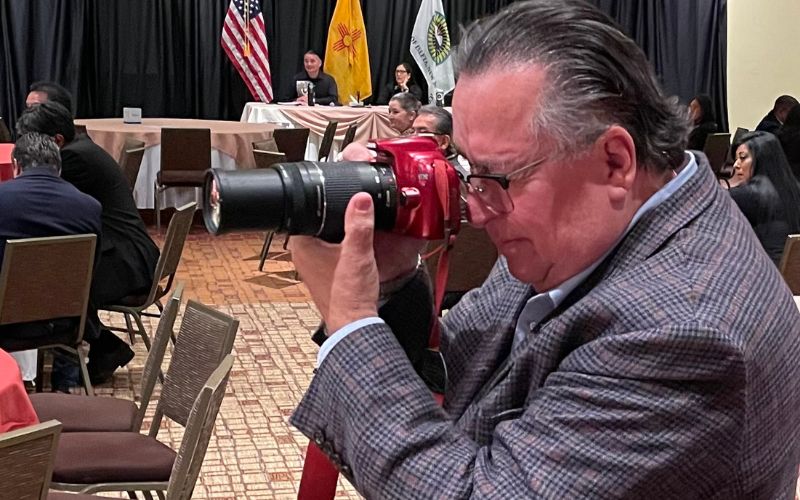
- Details
- By Jenna Kunze
The Department of the Interior’s Road to Healing tour began in July 2022 in Anadarko, Oklahoma, with one goal in mind: for the federal government to document, for the first time, oral histories from Indian Boarding School survivors and their descendants.
Over the course of 16 months, Secretary of the Interior Deb Haaland (Laguna Pueblo) and Assistant Secretary Bryan Newland (Bay Mills Indian Community) traveled to 12 communities across the United States to hear testimonies from boarding school survivors and their descendants.
So, too, did Native News Online. Publisher and editor Levi Rickert (Prairie Band Potawatomi Nation) attended 11 of the12 stops across Indian Country, traveling as close as his home state of Michigan and as far as Anchorage, Alaska, to bear witness to, document, and share the true history of the United States’ nearly 200 year Indian Boarding School policy. I attended the stop Levi was unable to make in Rosebud, South Dakota.
In the auditorium at the White House Tribal Summit, I asked Levi about his experience bearing witness to such a history that’s both personal and professional for him.
EDITOR'S NOTE: This transcript has been edited for brevity and clarity.
 Make A Donation Here
Make A Donation Here
Native News Online: It’s been a year of the Road to Healing Tour, and you’ve been to 11 of the 12 stops across the country. What’s been your impression of the tour?
Levi Rickert: When it was initially announced, I had my reservations that survivors, and even their descendants, would come forth and open up their hearts and minds in remembrance of what happened. I was wondering what good that would do: opening up this scab.
But as the year continued, I started seeing the strength in people telling their stories, tragic as they may be. I think that provided healing. Time and time again, I would hear people say, ‘No one’s ever heard this story before.’ I think that’s pretty significant. It’s the old saying: the truth shall set you free. Well, I think that that’s it. Some of this stuff has been caged inside elders’ heads for many decades, and it freed them of some of their pain and anguish.
Native News Online really made a commitment to attend all the sessions after the first three. We realized what was happening during the Road to Healing sessions was history in the making. Thirty years from now, people will reflect back and read about this in history books. Hopefully, they will read that it was a real turning point to overcome historical trauma that has plagued our families for generations.
Native News Online: What were some common themes that you heard from survivors across the country?
Rickert: I think that’d be maybe one of the reasons why Native News Online decided we wanted to go to all of the stops was to see what comparisons there may be between regions.
A common thread was the physical, emotional, and sexual abuse that happened every single region. So it was pretty consistent throughout the boarding school system. That was somewhat eye-opening because I really wanted to find out what the differences were. And there really were no differences.
Native News Online: Over the course of the 16-month tour, did you notice better attendance as more truth and healing grassroots efforts have sprung up across the country?
Rickert: I think the turnout was pretty consistent. There was one that took place on graduation week up in Minnesota, and it had a smaller crowd. But other than that, most of them were pretty much the same time, the same intensity. There were times that I would think to myself while driving to it: ‘Maybe this forum won’t be quite as bad as the last.’ And generally, they were all just as bad, if not worse.
Native News Online: What do you see as your responsibility to the survivors and their stories now that you carry them?
Rickert: I think that as the publisher of Native News Online, it’s incumbent on us to continue the story. Just because the Road to Healing Tour has ended, and we are awaiting [Volume 2] of the Department of Interior’s investigative report, our work will continue, perhaps by conducting more oral histories with survivors themselves and monitoring behavioral health in Indian Country.
Native News Online: What was it like to observe Secretary Haaland, who is paving the way in this arena on behalf of the very Department once leading these assimilation policies?
Rickert: I have an enormous amount of respect for Secretary Haaland. The idea that she’s the first American Indian ever to serve in a Secretary role within a presidential cabinet is historic. She has been there for us. I would watch the look on her face as she walked in every single session. It was basically the same; she had a stoic look as we Natives are known for, but she had boxes of tissue at every stop, and she used those tissues. There was one stop where I saw her get out of her seat and go give the tissues to somebody in the third row back who was crying. I was pretty impressed by that. There was a stop on the Navajo Nation where a woman had driven down from Utah who said ‘When Secretary Haaland was confirmed, this woman prayed to the Creator she could meet her. And the Creator answered her prayers. That let me see the representation of who Deb Haaland really is and what she means to Indian Country.
Native News Online: It’s called the Road to Healing Tour. Did you feel a significant movement towards healing through truth-telling?
Rickert: I felt like there was healing taking place in the coming together of tribal communities. I think the most symbolic time was when we participated in the raising of a totem pole up in Anchorage, Alaska. Assistant Secretary Brian Newland helped carry it. I looked around and Deb Haaland, the Secretary of the Interior, was laying cedar on the pole to give it a blessing as part of the custom. To look around the arch and see close to 500 people who had come from various parts of Alaska was a very powerful experience.
Native News Online: Given this is your own family’s history with boarding school, how did the Road to Healing tour impact you personally?
Rickert: It was actually a road to healing for me, too, as a Native person. To me, the conclusion from the tour was that in order to move forward, we have to heal as tribal communities. So what Secretary Haaland and Assistant Secretary Newland did was pretty powerful for Indian Country overall so that we can reckon with our history and move forward.
More Stories Like This
Native News Weekly (August 25, 2024): D.C. BriefsUS Presidents in Their Own Words Concerning American Indians
Native News Weekly (January 18, 2026): D.C. Briefs
Federal Judge Orders ICE to Halt Use of Pepper Spray, Arrests of Peaceful Protesters in Twin Cities
Tunica-Biloxi Cultural Leader John D. Barbry Walks On
Help us defend tribal sovereignty.
At Native News Online, our mission is rooted in telling the stories that strengthen sovereignty and uplift Indigenous voices — not just at year’s end, but every single day.
Because of your generosity last year, we were able to keep our reporters on the ground in tribal communities, at national gatherings and in the halls of Congress — covering the issues that matter most to Indian Country: sovereignty, culture, education, health and economic opportunity.
That support sustained us through a tough year in 2025. Now, as we look to the year ahead, we need your help right now to ensure warrior journalism remains strong — reporting that defends tribal sovereignty, amplifies Native truth, and holds power accountable.
 The stakes couldn't be higher. Your support keeps Native voices heard, Native stories told and Native sovereignty defended.
The stakes couldn't be higher. Your support keeps Native voices heard, Native stories told and Native sovereignty defended.
Stand with Warrior Journalism today.
Levi Rickert (Potawatomi), Editor & Publisher

